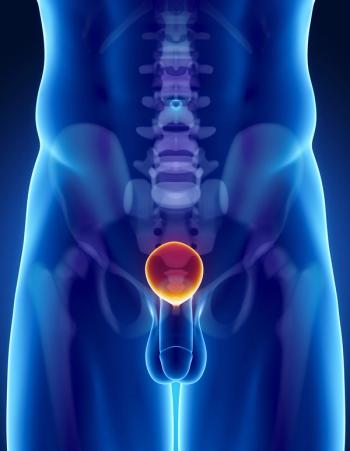
Tiragolumab/Atezolizumab Does Not Meet PFS End Point in NSCLC
The SKYSCRAPER-03 trial revealed that tiragolumab plus atezolizumab failed to improve progression-free survival compared with durvalumab in NSCLC.
The primary end point of independent review facility (IRF)-assessed progression-free survival (PFS) was not met when consolidation tiragolumab plus atezolizumab (Tecentriq) compared with standard durvalumab (Imfinzi) in patients with locally advanced, unresectable, stage III non–small cell lung cancer (NSCLC) who have not progressed after platinum-based concurrent chemoradiation (cCRT), according to results from the phase 3 SKYSCRAPER-03 trial (NCT04513925) presented at the
At a median follow-up of 30.7 months, the median IRF-PFS in the overall population was 14.2 month (95% CI, 12.6-19.2) in patients treated with the combination vs 13.8 months (95% CI, 10.9-17.0) in patients treated with durvalumab (HR, 1.00; 95% CI, 0.84-1.19). The 24-month PFS event-free rates were 39.0% and 38.5%, respectively. The median overall survival (OS) was 45.6 months (95% CI, 37.1–not evaluable [NE]) vs 45.8 months (95% CI, 36.9-NE), respectively (HR, 0.98; 95% CI, 0.80-1.20). The 24-month OS event-free rates were 67.0% vs 66.3%, respectively.
The primary end point was also missed in PD-L1–positive patients (Tumor Cell [TC] score ≥1%) with a median IRF-PFS of 19.4 months vs 16.6 months in patients treated with the combination vs durvalumab, respectively (HR, 0.96; 95% CI, 0.75-1.23; P = .7586). The median OS in these patients was NE vs 54.8 months, respectively (HR, 0.99; 95% CI, 0.73-1.34). The 24-month PFS and OS event-free survival rates were 46.1% vs 42.9% and 72.2% vs 69.2%, respectively.
“SKYSCRAPER-03 did not meet its primary end point of IRF-PFS. There were no new or unexpected [safety] findings,” said first study author Rafal Dziadziuszko, MD, PhD, department of oncology and radiotherapy of the Medical University of Gdansk, Poland.
What Was the Safety Profile of the Combination and Monotherapy Arms in the SKYSCRAPER-03 trial?
“Tiragolumab plus atezolizumab demonstrated a tolerable safety profile, consistent with previous observations for the combination,” said Dziadziuszko.
Grade 3/4 treatment-related adverse events (TRAEs) occurred in 13.8% of patients in the combination arm, with serious TRAEs experienced by 11.5%. There were 2 patient deaths considered to be related to the combination treatment. In the durvalumab arm, grade 3/4 TRAEs and serious TRAEs each occurred in 10.7% of patients. There were 7 patient deaths considered to be related to durvalumab treatment.
What Was the Study Rationale and Design for the SKYSCRAPER-03 trial?
Regarding the rationale for the study, Dziadziuszko explained, “Consolidation durvalumab is the standard of care for patients with unresectable, stage III NSCLC that has not progressed following cCRT; however, disease recurrence [still] represents an unmet need.”
He added that the immune checkpoint target TIGIT has a role in cancer immune evasion and the study hypothesis was that tiragolumab, an anti-TIGIT monoclonal antibody, could potentially augment antitumor activity when used in combination with immunotherapies such atezolizumab.
The open-label phase 3 SKYSCRAPER-03 trial was launched to test this hypothesis in patients with newly diagnosed, unresectable, stage III NSCLC whose disease has not progressed following at least 2 cycles of definitive platinum-based cCRT. Patients had to have known PD-L1 status, and an ECOG performance status of 0 or 1. Patients with EGFR- or ALK-positive tumors were not eligible for enrollment.
At 1 to 42 days post cCRT, patients were randomized in a 1 to 1 ratio to combination therapy with tiragolumab (840 mg IV every 4 weeks) plus atezolizumab (1680 mg IV every 4 weeks) or single-agent durvalumab (10 mg/kg IV every 2 weeks or 1500 mg IV every 4 weeks). Patient could receive up to 13 cycles of treatment (28-day cycles).
The primary end point was PFS assessed by an independent review facility in patients with PD-L1–positive (Tumor Cell [TC] score ≥1%) as well as PD-L1 all-comers. Secondary end points included OS, duration of response, objective response rate, patient-reported outcomes, and safety.
What Were the Patient Characteristics in the SKYSCRAPER-03 trial?
Patient characteristics were well balanced between the 2 study arms. The median age was 64 years (range, 35-84) in the combination arm vs 65 years (range, 41-86) in the durvalumab arm. About half of patients in each arm were aged less than 65 years at 50.8% and 47.4%, respectively. About 80% of patients in each arm were male, about 60% were White, and about 35% were Asian. Patients’ ECOG performance status was mostly split evenly between 0 and 1, with a slightly higher number of patients in each arm at ECOG 1 status. About 75% of patients in each arm were former tobacco users and about 20% were current tobacco users.
About 50% of patients in each arm had a PD-L1 TC score of <1%, with about 25% of patients having a score of 1%-49%, and the remaining patients having a score of ≥50%. Tumor staging prior to definitive cCRT showed that 41.1% of patients receiving the combination had stage IIIA tumors vs 39.6% of patients in the single-agent arm. Rates of stage IIIB and stage IIIC tumors were 47.4% vs 44.4% and 11.4% vs 16.0%, respectively. About 60% of patients in each arm had squamous histology and about 40% had non-squamous histology. Best response to concurrent chemoradiotherapy in the combination vs durvalumab arms was complete response (0.5% in each arm), partial response (59.7% vs 61.4%), and stable disease (39.8% vs 38.1%).
In his concluding remarks, Dziadziuszko did not report any next steps for the combination of tiragolumab plus atezolizumab in this setting.
Disclosures
Dziadziuszko disclosed relationships with AstraZeneca, Boehringer Ingelheim, BMS, Pfizer, Takeda, Eli Lilly, BioNTech, Novartis, and Roche.
Reference
Dziadziuszko R, Ahn M-J, Bradley JD, et al. SKYSCRAPER-03: Phase III, open-label, randomised study of atezolizumab (atezo) + tiragolumab (tira) vs durvalumab (durva) in locally advanced, unresectable, stage III non-small cell lung cancer (NSCLC) after platinum-based concurrent chemoradiation (cCRT). Presented at: 2025 ESMO Congress; October 17-21, 2025; Berlin, Germany. Abstract LBA69.
Newsletter
Stay up to date on recent advances in the multidisciplinary approach to cancer.


















































































